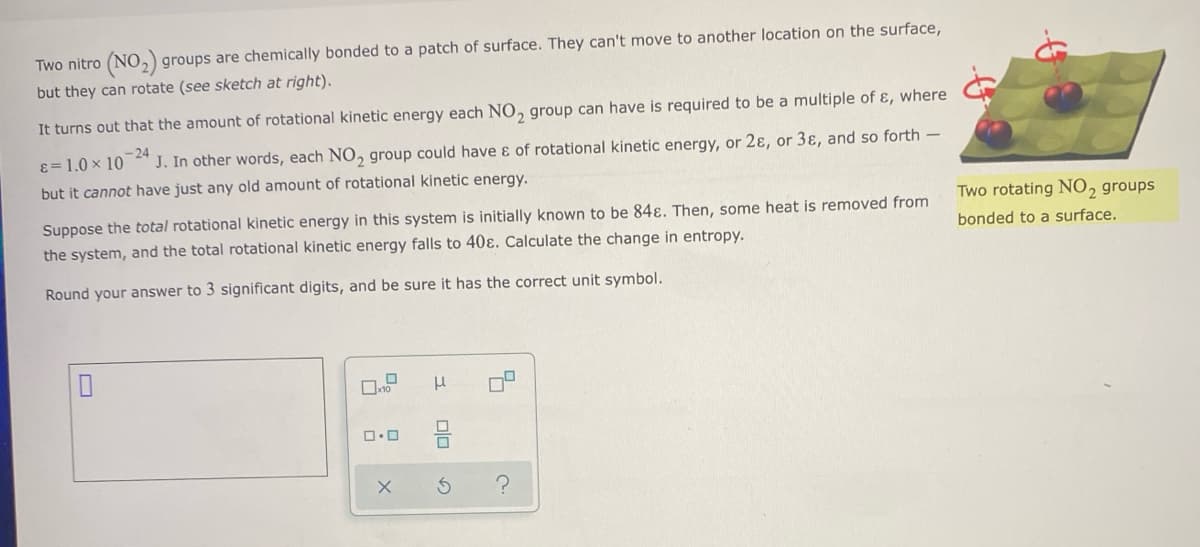Two nitro (NO,) groups are chemically bonded to a patch of surface. They can't move to another location on the surface, but they can rotate (see sketch at right). It turns out that the amount of rotational kinetic energy each NO, group can have is required to be a multiple of ɛ, where E= 1.0 x 10 -24 J. In other words, each NO, group could have ɛ of rotational kinetic energy, or 2ɛ, or 3ɛ, and so forth - but it cannot have just any old amount of rotational kinetic energy. Suppose the total rotational kinetic energy in this system is initially known to be 84ɛ. Then, some heat is removed from Two rotating NO, groups the system, and the total rotational kinetic energy falls to 40ɛ. Calculate the change in entropy. bonded to a surface. Round your answer to 3 significant digits, and be sure it has the correct unit symbol.
Two nitro (NO,) groups are chemically bonded to a patch of surface. They can't move to another location on the surface, but they can rotate (see sketch at right). It turns out that the amount of rotational kinetic energy each NO, group can have is required to be a multiple of ɛ, where E= 1.0 x 10 -24 J. In other words, each NO, group could have ɛ of rotational kinetic energy, or 2ɛ, or 3ɛ, and so forth - but it cannot have just any old amount of rotational kinetic energy. Suppose the total rotational kinetic energy in this system is initially known to be 84ɛ. Then, some heat is removed from Two rotating NO, groups the system, and the total rotational kinetic energy falls to 40ɛ. Calculate the change in entropy. bonded to a surface. Round your answer to 3 significant digits, and be sure it has the correct unit symbol.
Related questions
Question

Transcribed Image Text:Two nitro (NO,) groups are chemically bonded to a patch of surface. They can't move to another location on the surface,
but they can rotate (see sketch at right).
It turns out that the amount of rotational kinetic energy each NO, group can have is required to be a multiple of ɛ, where
ɛ=1.0 x 10
-24
J. In other words, each NO, group could have ɛ of rotational kinetic energy, or 2ɛ, or 3ɛ, and so forth –
but it cannot have just any old amount of rotational kinetic energy.
Suppose the total rotational kinetic energy in this system is initially known to be 84ɛ. Then, some heat is removed from
Two rotating NO, groups
the system, and the total rotational kinetic energy falls to 40ɛ. Calculate the change in entropy.
bonded to a surface.
Round your answer to 3 significant digits, and be sure it has the correct unit symbol.
Expert Solution
This question has been solved!
Explore an expertly crafted, step-by-step solution for a thorough understanding of key concepts.
This is a popular solution!
Trending now
This is a popular solution!
Step by step
Solved in 2 steps with 2 images
